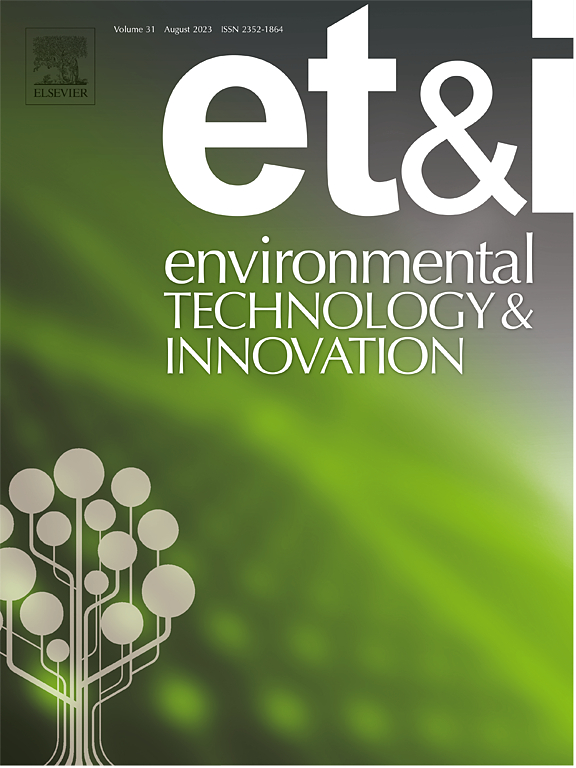Microbial-driven soil remediation: Comparative analysis of seven microbial agents on alachlor degradation rates and tobacco phytotoxicity recovery
IF 6.7
2区 环境科学与生态学
Q1 BIOTECHNOLOGY & APPLIED MICROBIOLOGY
引用次数: 0
Abstract
The presence of alachlor residue in soil has been demonstrated to exert a deleterious effect on the subsequent cultivation of crops, resulting in substantial impairment to agricultural output. Application of alachlor at twice the recommended dose notably inhibited tobacco growth, reducing plant height to 39.68 % of the control, stem girth to 40.06 %, maximum leaf length to 45.52 %, and maximum leaf width to 42.05 %. A total of seven functional microbial agents were screened for their potential to alleviate tobacco phytotoxicity. Results demonstrated that two microbial agents, Purpureocillium lilacinum (PL) and Pseudomonas fluorescens (PF), significantly alleviated toxicity, enhancing plant height, stem girth, and leaf expansion (P < 0.001 or P < 0.01). This study also developed and validated an efficient method for detecting alachlor in soil, demonstrating excellent linearity (R² > 0.99) with recoveries ranging from 88.98 % to 93.60 %, a limit of detection (LOD) of 0.0005 mg/kg, and a limit of quantification (LOQ) of 0.02 mg/kg. The degradation efficiency of alachlor varied among microbial agents, with PL and PF exhibiting the highest degradation rates of 93.50 ± 0.69 % and 90.80 ± 1.02 % at 70 days post-application. Microbial diversity analysis showed that PL and PF treatments increased the abundance of Actinobacteria and specific microbial genera, which facilitated alachlor degradation and improved soil ecological conditions. These findings suggest that PL and PF hold significant potential to accelerate alachlor degradation, alleviate alachlor toxicity, and enhance soil health, offering valuable insights for farmland pollution remediation.
微生物驱动的土壤修复:7种微生物剂对甲草胺降解率和烟草植物毒性恢复的比较分析
土壤中甲草胺残留的存在已被证明对作物的后续种植产生有害影响,对农业产量造成重大损害。施用两倍推荐剂量的甲草胺显著抑制烟草生长,使株高降至对照的39.68 %,茎长降至对照的40.06 %,最大叶长降至45.52 %,最大叶宽降至42.05 %。筛选了7种具有减轻烟草植物毒性潜力的功能性微生物制剂。结果表明,紫丁香紫色单胞菌(PL)和荧光假单胞菌(PF)显著减轻了紫丁香紫色单胞菌的毒性,增加了植株的株高、茎长和叶片的膨大(P <; 0.001或P <; 0.01)。本研究还开发并验证了一种有效的检测土壤中甲草胺的方法,该方法具有良好的线性(R²>;0.99),加样回收率为88.98 % ~ 93.60 %,检出限为0.0005 mg/kg,定量限为0.02 mg/kg。不同微生物对甲草胺的降解效率不同,施用后70 d, PL和PF的降解率最高,分别为93.50 ± 0.69 %和90.80 ± 1.02 %。微生物多样性分析表明,有机肥和有机肥处理增加了放线菌和特定微生物属的丰度,促进了甲草胺的降解,改善了土壤生态条件。研究结果表明,有机酸和有机酸具有显著的加速甲草胺降解、减轻甲草胺毒性和改善土壤健康的潜力,为农田污染修复提供了有价值的见解。
本文章由计算机程序翻译,如有差异,请以英文原文为准。
求助全文
约1分钟内获得全文
求助全文
来源期刊

Environmental Technology & Innovation
Environmental Science-General Environmental Science
CiteScore
14.00
自引率
4.20%
发文量
435
审稿时长
74 days
期刊介绍:
Environmental Technology & Innovation adopts a challenge-oriented approach to solutions by integrating natural sciences to promote a sustainable future. The journal aims to foster the creation and development of innovative products, technologies, and ideas that enhance the environment, with impacts across soil, air, water, and food in rural and urban areas.
As a platform for disseminating scientific evidence for environmental protection and sustainable development, the journal emphasizes fundamental science, methodologies, tools, techniques, and policy considerations. It emphasizes the importance of science and technology in environmental benefits, including smarter, cleaner technologies for environmental protection, more efficient resource processing methods, and the evidence supporting their effectiveness.
 求助内容:
求助内容: 应助结果提醒方式:
应助结果提醒方式:


